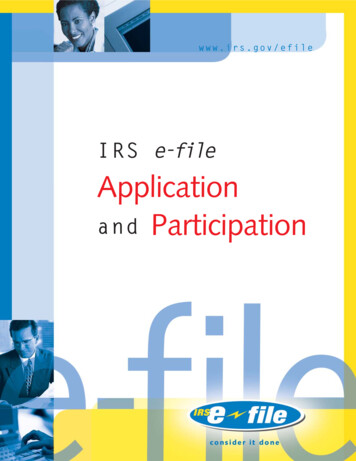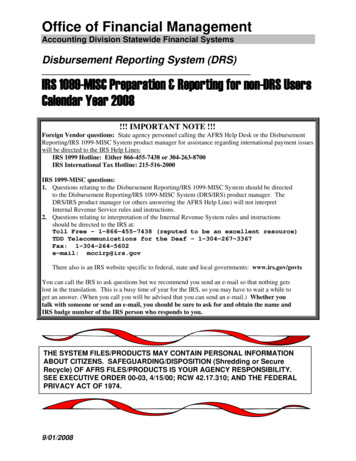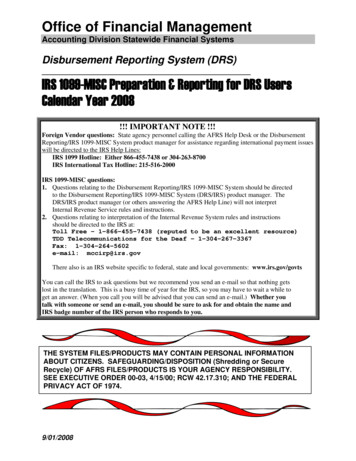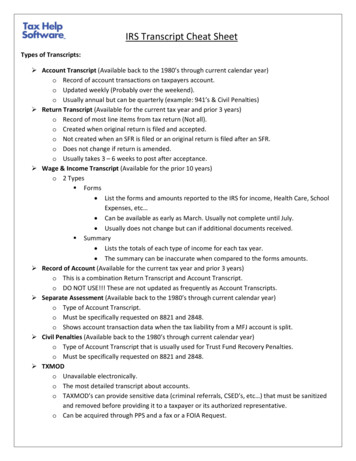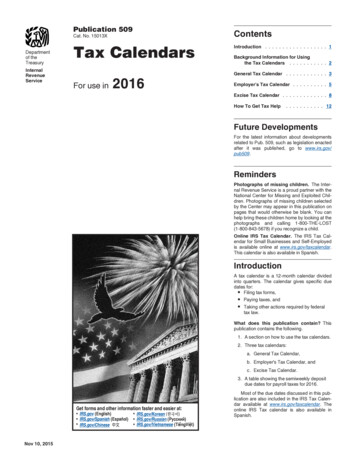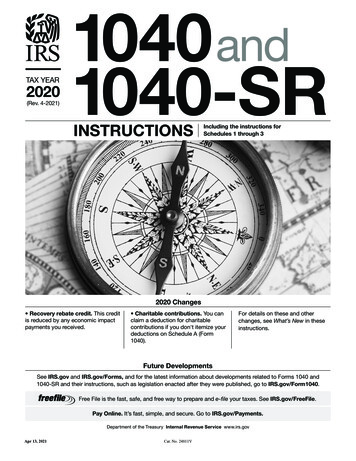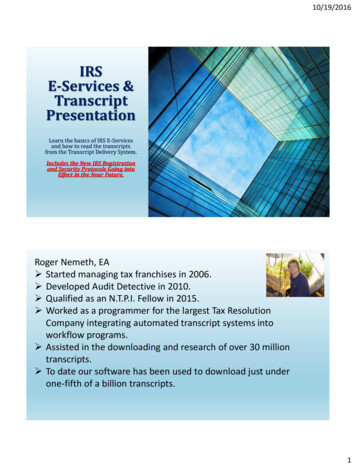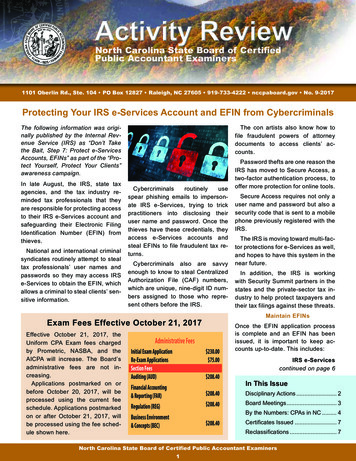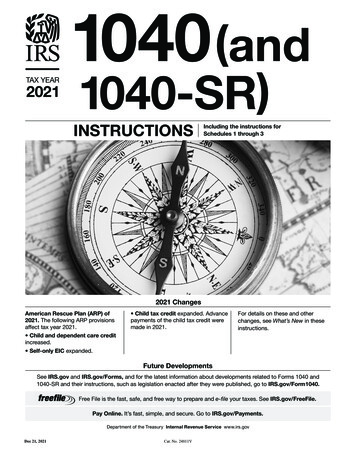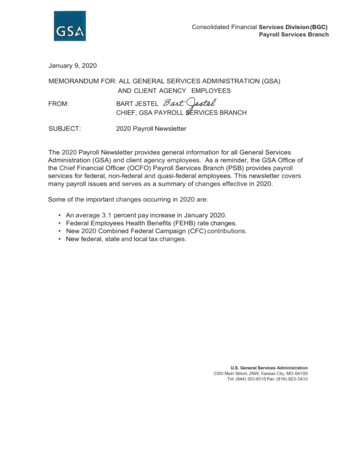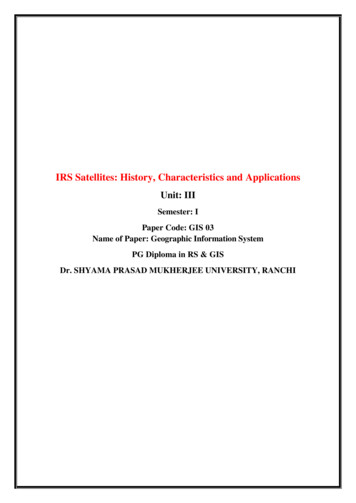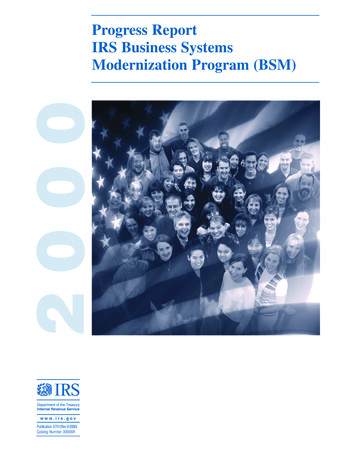
Transcription
2000Progress ReportIRS Business SystemsModernization Program (BSM)www.irs.govPublication 3701(Rev. 9-2000)Catalog Number 30956R
Business Systems Modernization Progress ReportMessage from the Commissioner . 2Executive Summary . 3Section 1Background. 8Section 2.Management . 10Section 3.Tangible Project Deliverables . 16Section 4.Enterprise Vision and Architecture. 21Section 5.Risks . 23Section 6.Funding . 25Attachments:Attachment 1. CBS ESC meetings (March -August 2000) and Samples of Agenda TopicsAttachment 2. GAO, TIGTA and House Ways and Means Committee, Sub-Committee onOversight Engagements and Audits on the BSM Program and Project AreasAttachment 3. Deliverables from e-services and Customer Communications ProjectsAttachment 4. List of Task OrdersAttachment 5. Integrated Master ScheduleAttachment 6. Summary Status of On-going ProjectsAttachment 7. Key Deliverables Dates for ArchitectureAttachment 8. Program Level Risks as of September 1, 2000Attachment 9. Summary of Information Technology Investment Account FundingIRS Business Systems Modernization Program Progress Report1
Message from the Commissioner of Internal RevenueThe US economy has achieved impressive increases in productivity through investments ininformation technology. The IRS, which is still dependent on systems installed in the 1960s and1970s, has established the Business Systems Modernization Program to take advantage of newtechnology to revamp the way we do business. I firmly believe the program is on the path tosucceed.In only 14 months since the first funds were released, we have put in place the initial elementsneeded for success. These include dedicated executive leadership, a disciplined methodology, astringent review and approval process, and a clear vision for how we will transform our businessoperations. We have already completed tangible deliverables for initial projects that will deliverreal business results beginning in 2001, and we will soon publish our overall enterprisearchitecture plan – Blueprint 2000 – which represents a major update to the previous blueprintpublished in 1997. Having built the foundation, the program will continue to mature as we gainexperience.While not without start-up problems, our initial experience with this program comparesfavorably with major successful business systems programs undertaken elsewhere in the privateand public sectors, few of which approach the scale of the IRS’s program. We have carefullyassessed the factors that have led to success and failure at the IRS and elsewhere in majorsystems programs. We have also benefited from the comments of oversight bodies. Because weunderstand and recognize the risks inherent in the program, we are committed to managing theserisks aggressively and are confident we can succeed.The enclosed report describes important milestones we have reached as well as upcoming work.Through modernizing our business systems, we are working to improve and expand our serviceto America’s taxpayers.Sincerely,Charles O. RossottiCommissioner of Internal RevenueIRS Business Systems Modernization Program Progress Report2
Internal Revenue ServiceBusiness Systems Modernization ProgramProgress ReportSeptember 1, 2000Executive SummaryThe purpose of this report is to review the progress of the IRS Business Systems ModernizationProgram (BSM) over the past 14 months.The U.S. tax administration system, which collects 2 trillion in revenues each year, is criticallydependent on a collection of obsolete computer systems developed by the IRS over the last 35years.These systems are fundamentally deficient. They do not and cannot allow the IRS to administerthe nation’s tax system and provide essential service to taxpayers at an acceptable level ofefficiency, effectiveness and risk. The fact that the IRS has struggled for years to modernize itstechnology, with only limited success, points to the difficulties and inherent risks of thisenormous task.Recognizing the long-term commitment needed to solve this critical national problem – one ofthe largest and most sensitive business systems modernization programs ever undertaken in theUnited States – Congress set up a special Information Technology Investment Account (ITIA).This program aims to raise IRS’s business systems to a level equivalent to best practice in theprivate and public sectors while managing the risks inherent in the program.In only 14 months since the first release of ITIA funds on June 28, 1999, the program has madevery substantial progress in the three key areas needed for long-term success. These are: (1)establishing a rigorous and effective management process that will continue to mature over time;(2) producing tangible deliverables for a set of initial projects that will begin to produce realbusiness results in 2001 – less than two years after the first release of funds; and (3) updating thebusiness vision and architecture to reflect recent experience gained in the IRS and elsewhere toguide the program over the longer term.While not without start-up problems, our initial experience with this program comparesfavorably with major successful business systems programs undertaken elsewhere in the privateand public sectors – few of which approach the scale of the IRS’s program.ManagementThe IRS Business Systems Modernization Program is one of the largest business systemsprojects in the United States, and must be managed with discipline and rigor. Over the past 14months, a great deal of progress has been made in establishing an effective management process,although much more remains to be done. Because of the program’s size, expected improvementsIRS Business Systems Modernization Program Progress Report3
can only take place by gaining practical experience. Some of the elements we have included toestablish the management process are as follows:Executive Steering Committee (ESC). Through the Core Business Systems ESC,chaired by the Commissioner, the IRS established an active, effective top-levelgovernance process for the Business Systems Modernization Program. This committeehas met six times in the last five months and approves all funding and other keydecisions. Membership of this committee includes senior representatives from theTreasury Department and other key executives and stakeholders.Experienced IRS Management Team. The IRS put together a Business SystemsModernization Program management team that includes three executives with a lifetimeof experience in the private sector, and key internal executives with many years ofexperience in tax systems and tax administration.Strengthened PRIME Management Team. Over the last few months, the PRIME(Prime Systems Integration Services Contract) Alliance strengthened its programmanagement team by adding a second experienced program manager and a systemarchitect.Clear Roles and Responsibilities. In June 2000, a major effort was made to clarify rolesand responsibilities within the Business Systems Modernization Office and the PRIME.Proven Methodology. The IRS adopted the proven Catalyst Methodology fromComputer Sciences Corporation (CSC) as the basis for all work. From April to June,intensive training of IRS and PRIME Alliance personnel was conducted on this provenmethodology. All of the projects were reviewed and approved to ensure compliance.Active Contracts Management. A major risk in the program earlier this year was thelack of completed task order contracts. This backlog has been largely cleared up andperformance contracts have been completed for most of the major task orders.Program Management Reviews. A regular series of intensive programmanagement reviews has been started to review technical specifications, cost andschedule for each project.Integrated Master Schedule. An IMS has been developed and is being maintained toidentify how different projects relate to and depend on each other.Management Information Center. A management information center has beenestablished to centralize status reporting for the entire program.Calculated Investment Decisions. Investment decisions are based on a rigorous processincluding both analysis of the overall systems portfolio and thorough reviews of businesscases as each project progresses through the life cycle.IRS Business Systems Modernization Program Progress Report4
While the management process for the program is improving rapidly, it still needs furthermaturation to cope with the expanded level of activity that will occur in 2001 and 2002. Ourgoal is to achieve an acknowledged industry management standard (Capability Maturity ModelLevel 2) for systems acquisition by September 30, 2001, which can only be achieved withexperience in managing the program. The Capability Maturity Model (CMM) describes theprinciples and practices underlying software process maturity and is intended to help softwareorganizations improve the maturity of their software processes in terms of an evolutionary pathfrom ad hoc, chaotic processes to mature disciplined software processes. Reaching the level 2 inCMM means that the basic project management processes are established to track cost, scheduleand functionality. The necessary process discipline is in place to repeat earlier successes onprojects with similar applications.Tangible Deliverables for Initial ProjectsIn a first round of planning in 1999, a limited set of initial projects was defined on which workcould proceed at an acceptable risk level. This decision was based on the pre-existingModernization Blueprint. These initial projects will deliver substantial benefits beginning in2001 and 2002. They will also provide a practical means of developing and testing ourmanagement process and architecture, and lay down an essential foundation for subsequentprojects.The first system to be developed and deployed will be the Customer Communications System. Itwill allow the IRS to answer more of the 150 million telephone calls it receives, while providinga solid foundation for future systems, nearly all of which require communication with taxpayers.On May 22, 2000, this project became the first to meet all of the rigorous requirements fordeliverables and reviews prior to the development phase, and on June 22, 2000, a firm fixedprice task order was signed. Initial implementation is currently planned for the second quarter of2000 – less than two years after the first release of ITIA funds. In the context of the startup of anenormous, highly integrated and complex systems program, this is an exceptionally fast time forthe first major systems deployment.Following the implementation of Customer Communications, other major systems will bedelivered beginning in the second half of 2001, and will continue at regular intervals in 2002 andbeyond.In the last few months, four other projects have passed important milestones as defined in theEnterprise Life Cycle (ELC) methodology being used for all projects: The CRM Exam project will be the first system to use commercial applications software,allowing IRS examiners of corporate income tax returns to compute taxes accurately. Itcompleted Milestone 2 on July 10, 2000. Milestone 2 establishes a project concept, itsrequirements and design elements as a solution for a specific business area or system. Apreliminary business case is produced. The e-services project will accelerate our ability to meet the overall goal of convertingmost transactions with taxpayers and their representatives to electronic form. ItIRS Business Systems Modernization Program Progress Report5
completed Milestone 2 on August 8, 2000 and will be the first project to be developedusing the competitive solution selection method. The Customer Account Data Engine project is the most critical building block in theentire program. It will replace the 35 year-old “master file” system, which contains theauthoritative record of all taxpayer accounts. It completed Milestone 2 on August 8,2000. The Custodial Accounting Project will provide the capability to maintain requiredfinancial accounting controls over the 2 trillion of tax revenue received each year. Itreceived qualified approval to proceed to Milestone 4, on August 8 and on September 5,2000, received ESC approval to request release of ITIA funds for the first of four buildsegments. The business solution is built in Milestone 4. The system is integrated withother business systems, is tested, and piloted. The system is prepared for deployment atits intended sites.In addition, important progress has been made on key infrastructure projects that are required tosupport the business systems projects.Enterprise Vision and ArchitectureIn May 2000, the IRS began a major update to the original 1997 Modernization Blueprint, whichguided the program in the initial period. The objective of this new project, referred to asBlueprint 2000, is to reflect the substantial knowledge gained through experience, the changes inthe IRS organization and the improvements in available technology that have taken place overthe last three years.One of the most important aspects of Blueprint 2000 is the greater emphasis on business vision –stating clearly how the main aspects of tax administration will operate differently in the futurewith the help of technology.At the present time, very important work has been completed on the business vision and theenterprise architecture update. The entire tax administration process has been carefully defineddown to three levels of detail, specifying how speed, accuracy and timeliness will improvedramatically. On the technical side, key topics such as data architecture and security are beingaddressed, with the Blueprint updated to reflect them.Subsequent to completion of the updated enterprise vision and architecture, an analysis will bedone to develop migration plans and to propose possible priorities and sequences for all furtherprojects. This plan will be developed and the prioritization decisions considered during Januaryand February of 2001, in time to continue progress beyond the currently planned projectdeliverables in 2001 and 2002. This planning will be a key part of the ongoing investmentdecision process.RisksDue to its enormous size, complexity and sensitivity, the Business Systems ModernizationProgram involves considerable risk. However, the fact that there is risk does not mean that theIRS Business Systems Modernization Program Progress Report6
program will fail. But it does mean that the program could fail if the risks are not adequatelyidentified and appropriate action taken to address them on a timely basis.The IRS is actively identifying and managing the risks, and has not hesitated to make changes inthe program when necessary. For example, in February the initially proposed program wasscaled back significantly because management processes were not yet at an adequate level.Since April, many serious program risks have been reduced or eliminated because of actionstaken. However, new risks are constantly identified. The most critical point to understand aboutmanaging risks in this program is that making constant adjustments to plans is an indication thatrisks are being addressed and managed.FundingFunding for the program is provided through a special Information Technology InvestmentAccount. This entails four distinct procedures, each with its own sets of steps and organizationalcomponents: appropriations, funding releases, ESC approval, and contracting. Through fiscal2000, Congress has appropriated 506 million, of which 249 million has been released(including one pending request of 32.7) and 224 million will have been obligated. The pace ofspending is accelerating as projects successfully complete early planning milestones and proceedinto detailed design and execution.By setting up the ITIA account, Congress wisely decided that this program required both, anassured source of funding and rigorous monitoring and oversight, before funds were actuallyexpended. To realize and build on the progress to date, and to meet RRA 98’s mandates, it isessential that this account continue to be funded.IRS Business Systems Modernization Program Progress Report7
Section 1. BackgroundThe US tax system, which produces over 2 trillion in gross revenue each year comprising 95%of the government's revenue, is critically dependent on a collection of computer systemsdeveloped by the IRS over a 35 year period. Nearly all IRS employees depend on thesecomputer systems to do their daily jobs, including over 70,000 individuals who use these systemsto deliver direct service to taxpayers. This collection of installed systems is very large,comprising a network of 40 mainframe computers, 871 midrange computers, over 100,000individual computers, 2,779 vendor supplied software products and over 50 million lines of IRSmaintained computer code. In a three-year period, the IRS was forced to spend over 1.4 billionjust to make these systems avoid catastrophic failure after the century date change.In addition, and of foremost importance, the American public has a legitimate expectation thatthe IRS will do its job, no less effectively than high quality private or public sector organizations.When the IRS Restructuring and Reform Act of 1998 was enacted, the message was clear: theIRS must do a better job in meeting the needs of all taxpayers. Through the modernizationeffort, the IRS will rise to a much higher level of performance, providing all customers, ouremployees and the public with top quality service and treatment.While very large and critically important, the IRS systems are fundamentally deficient and donot allow the IRS to administer the tax system at an acceptable level of efficiency, effectivenessand risk. The most important systems, which maintain all taxpayer records, were developed inthe 1960s and 1970s. Many other systems to perform specific functions have been added overthe years as the tax code evolved and as new technology became available. This network ofsystems was never designed or planned. Consequently, current data on taxpayers is ofteninconsistent imposing immense burdens on taxpayers and employees who use the systems. Inaddition, making changes to cope with new tax laws or new services is extremely slow andunreliable. As GAO has pointed out, the IRS runs serious risk in accounting for funds andmaintaining acceptable security of critical data and systems, risks which cannot be fullyaddressed with the existing systems. And finally, the IRS cannot realize the enormous potentialof the Internet to improve service and reduce costs without replacing its obsolete and deficientsystems.These major problems have persisted despite previous attempts at technology modernization.The lack of success of previous modernization efforts points up the risks and complexity ofreplacing such a large, old, and complex set of systems. But, the risks of not modernizing arepotentially catastrophic. Therefore, there is no risk-free course. The purpose of the IRSBusiness Systems Modernization program is to modernize the IRS business systems raising themto a level equivalent to best practices in the private and public sectors, while managing theinherent risks of the process.Recognizing the necessity for a major effort, the Congress in FY98 set up an InformationTechnology Investment Account and to date has appropriated 506 million. In 1997, the IRSpublished its first comprehensive technology blueprint for the modernized systems. InDecember 1998, the IRS selected a PRIME contract to partner with the private sector inmanaging the program.IRS Business Systems Modernization Program Progress Report8
The first funds from the ITIA account, in the amount of 35 million, were released to the IRS onJune 28, 1999, to begin detailed planning for the program.Purpose and Time Period of This ReportThe purpose of this report is to provide the Congress and the public a concise summaryassessment of the progress of the IRS in the Business Systems Modernization Program, withemphasis on current status as the fiscal year comes to an end. The progress to date is the resultprimarily of the work done over the 14 month period from June 28, 1999 when the first ITIAfunds were released until September 1, 2000, the writing of this report.During this 14-month period, the first four months, from July through October 1999, were usedprimarily for planning of initial projects, initial staffing and training of the program managementoffice and project teams, and preparation of the next release of funds. The period fromNovember to April represented a startup of some of the initial projects and the discussion withvarious stakeholders of the first major funding request. During this period, IRS top managementconcluded that some scaling back of the initial proposed plan was required because themanagement process was not sufficiently developed to scale up activity as fast as initiallyexpected. Also, early in this period, an interim funding amount of 32.9 million was releasedpending approval of the full request. In addition, most of the program activity was stoppedduring a short period until the next release of funds, which occurred on April 18, 2000.Especially during the 5 months period since the April 18 release of funds, a great deal ofprogress has been made which can be summarized in three major categories: Management,Tangible Deliverables for Initial Projects and Enterprise Vision and Architecture.IRS Business Systems Modernization Program Progress Report9
Section 2. ManagementThe IRS business systems modernization program is certainly one of largest programs aimed atreplacing a full suite of mission critical business systems anywhere in the US. It must bemanaged with discipline and rigor, while nevertheless continuing to focus on results as well asprocess.There is no way to simply start up a high quality fully reliable management process for this kindof program in a short period of time. Instead, the quality and reliability of the process improvesover time with experience. The speed of improvement can be influenced by acquiringexperience from industry in the form of both executives and contractors, by building on previoussuccessful experience in the organization (in this case the extremely successful Y2K program),by training in proven methods, and by top-level management attention. The IRS is employing allof these means to accelerate the quality and reliability of the management process. Over the last14 months a great deal of progress has been made, although much more remains to be done.This continued improvement can only take place by gaining practical experience in managing theprogram.The following are some specific indications of progress on the management dimension.Executive Steering Committee (ESC)The modernization of IRS’s core systems requires sustained leadership from the top leaders ofthe entire organization. The highest, top-level oversight body for the whole program is the CoreBusiness Systems ESC that includes key executives from the IRS, is chaired by theCommissioner and includes senior representatives from the Treasury Department and other keyexecutives and stakeholders (such as National Treasury Employees Union, General AccountingOffice, Treasury Inspector General for Tax Administration and the Office of Management andBudget). The ESC provides a framework for the overall management of the process and issupported by the Business Systems Modernization Office (BSMO). In addition, there is a seriesof sub-ESCs, which focus more specifically on projects in their area of assigned responsibility.Each of the tiers of the governance structure has top executives representing the BusinessOperating Divisions (BODs), Information Systems (IS), the IRS PRIME, the FFRDC, and otherkey stakeholders. This management approach ensures that top management is engaged in atransition strategy for the entire agency that emphasizes business, technological and culturalchange.The CBS ESC meetings are scheduled to coincide with milestone and critical BSM programdecisions or as needed. The ESC thoroughly reviews the major elements of the program on aregular basis, including all major milestones. No funding for any project is released until theESC has approved completion of each milestone and the plan for the remaining milestones.This is not a routine, rubber stamped process. It is common for projects to either alter thedirection or to provide updated information before proceeding.The ESC has been very active. A list of CBS ESC meetings held from March through August2000 and samples of agenda topics are provided in Attachment 1.IRS Business Systems Modernization Program Progress Report 10
In addition to the dynamic, top-level oversight by the ESC, the BSMO Management Teamconducts weekly meetings with staff representatives from OMB, Treasury, GAO, and TIGTA onselected topics of interest to the oversight.Attachment 2 provides a listing of the GAO, TIGTA and House Ways and Means Committee,Subcommittee on Oversight ongoing engagements and audits on the BSM program and projectareas.IRS Management TeamThe IRS top-level management now embodies three individuals with many years ofmanagement experience in large-scale business systems programs. These are Charles Rossotti,Commissioner; Paul Cosgrave, CIO; and Bert Concklin, the Business Systems ModernizationExecutive. Concklin joined most recently, taking charge of the Business Systems ModernizationOffice (BSMO) on June 13, 2000. And, now that the Y2K program and much of thereorganization are complete, both the Commissioner and the CIO will have more time to devoteto assisting the BSMO in managing the program and especially in integrating it with othercomponents of the broader IRS.Tommy DeWeese, a key executive in the organizational modernization, has brought business andorganizational experience to BSMO in his role as Deputy Director, Business SystemsModernization Office. In addition, with the completion of the Y2K program, other individualswith experience in managing this huge program have been assigned to BSMO; namely, JohnYost, who was theY2K Program Manager and has now assumed the job of Director, Office ofProgram Management, in BSMO.Following are additional BSMO executives and their corresponding area of responsibility:Rick Skorny, Director, Tax Administration Vision and StrategyCurt Turner, Director, Office of Architectural EngineeringLauretta Brown, Director, Office of InfrastructureBarbara Jenkins, Director, CADE Program OfficeLisa Fiely, Acting Director, Integrated Financial Systems ProgramBill Conlon, Business Assurance ExecutiveBrady Bennett, Business Assurance ExecutiveIrene Scandiffio, Business Assurance ExecutiveNancy Rymer, Business Executive, Customer CommunicationsGreg Carson, Business Executive, e-servicesPRIME Top Management TeamThe PRIME top management team, led by James Kennedy, has been strengthened with theaddition of David Edmondson as Program Manager. Gordon Babcock, Director, ArchitecturalEngineering Office, and Greg Toth, Chief Architect, are leading the development of thearchitecture, an emerging discipline in information technology management. In addition,IRS Business Systems Modernization Program Progress Report 11
Steve Kalick, who has many years of experience working with Federal programs, has assumedoversight of the PRIME work. Fred Messing has recently joined the PRIME Top ManagementTeam as Director of Engineering.MITREMITRE, a federally funded research and development organization, provides independent, expertand objective strategic, technical, and program management advice, guidance, and supportservices to the Business Systems Modernization Office.MITRE provides support to the operation and modernization of tax systems, consistingprimarily of expert advice to help IRS officials determine, monitor, and evaluate the technicaldirection of the modernization effort in an environment free from both internal constraints andexternal market and profit-related influences. This organization also provides a critical infusionof expertise in the context of a special relationship and confidentiality, with freedom fromorganizational conflict of interest.Roles and ResponsibilitiesGiven the large number of individuals and organizations involved in the program, it is importantto clarify roles and responsibilities of the IRS executives and the contractors. It is particularlyimportant to establish the balance along two dimensions: accountability and partnership.Accountability is essential so that each organization and person understands what they are beingexpected to do and what their authority and responsibility are. But, it is also true that noorganization or individual can succeed alone since there are many interdependencies. In June2000, a major effort was made to clarify these roles and responsibilities, both within BSMO andin relation to the PRIME Alliance. This culminated in the approval and issuance of the BusinessSystems Modernization Organizational Change Framework (Volume 1: Organizational DirectionModel and Volume 2: Organizational Transition Plan), and a series of meetings and trainingsessions are being scheduled at which roles are being much more clearly defined. This in turnhas aided the completion of definitive task orders for the contractor.MethodologyThe IRS uses the Catalyst methodology from CSC, adapted for IRS as the Enterprise L
The CRM Exam project will be the first system to use commercial applications software, allowing IRS examiners of corporate income tax returns to compute taxes accurately. It completed Milestone 2 on July 10, 2000. Milestone 2 establishes a project concept, its requirements and design elements as a solution for a specific business area or .
